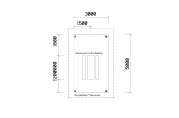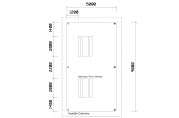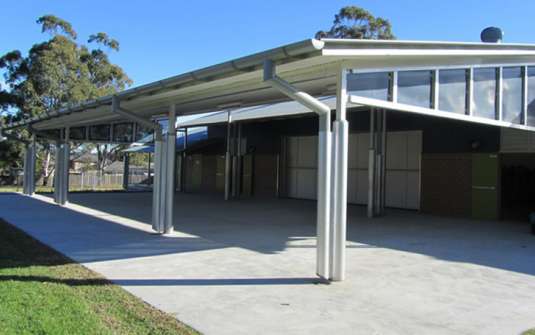This COLA provides a small flexible space that can provide an outdoor environment for learning and meetings. It can be used as a second withdrawal space. The durable surface supports activities that encourage individual and small groups to explore, investigate, create, fabricate and construct. Depending on the space and type of activity, small and medium sized groups can participate in rehearse and perform activities. The area can support small focussed storytelling, explicit teaching and demonstrations activities that require an exterior setting.
FURTHER OPPORTUNITIES
The location of the standalone COLA- with seating next to a Home Base will provide a shaded outdoor learning and social area for students and minimise the need to transport materials for learning activities. Such an area would allow teachers to create an extension of the Home Base learning settings to support more diverse learning processes including creative and construction learning activities, tabloid activities and structured play.
LEARNING IMPLICATIONS
Consideration would need to be given to acoustic and spatial implications depending on the number of groups, types of learning activities planned and proximity to activities occurring in the Hall and Home Base areas. For investigate, create, fabricate and construct activities, consideration would need to be given to the transport of materials for these activities. he COLA is generally not suitable for research, reflective, discussion, and reading activities.
Plans are also provided for COLAs that support larger schools. Although the Design Intent and Further Opportunities described apply to all plans, the Learning Implications and Ratings shown below are specific to PS504.03— Covered Outdoor Learning Area (COLA) – Large School – Type 3.
Explore ideas, share and develop opinions, debate and decide.
This learning process is effective with small to large groups provided specific criteria can be met.
Display, exchange and encounter learning artefacts.
This learning process is effective with small to very large groups provided specific criteria can be met.
Teachers and/or students demonstrate, communicate ideas and/or teach explicitly.
This learning process is effective with small to very large groups provided specific criteria can be met.
Hands on interaction, experimentation and evaluation with materials to discover, design and test.
This learning process is effective with small to very large groups provided specific criteria can be met.
Implement, build or assemble systems and media.
This learning process is effective with small to very large groups provided specific criteria can be met.
Use written, graphical and digital resources to personally reflect, consolidate and/or enquire.
This learning process is for individual or small groups and is effective provided specific criteria can be met.
Practise, refine and execute performance based activity.
This learning process is effective with small to very large groups provided specific criteria can be met.
Ratings against the Design Criteria
All criteria regarding spatial layout, fit-out, visibility and acoustics can be met.
Most criteria regarding spatial layout, fit-out, visibility and acoustics can be met. Some consideration will need to be given to determine whether constraints on ease of use, group size or materials will compromise the learning outcomes.
Few of the criteria regarding spatial layout, fit-out, visibility and acoustics can be met. A lot of consideration will need to be given to determine how the constraints on ease of use, group size or materials can be overcome.
Very few of the criteria regarding spatial layout, fit-out, visibility and acoustics can be met. This space should only be used for this learning mode as a last resort.
This space is incapable of supporting this learning mode.
This learning process is not employed with this size group.






